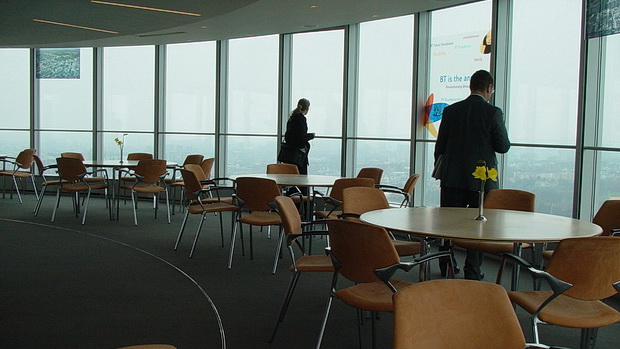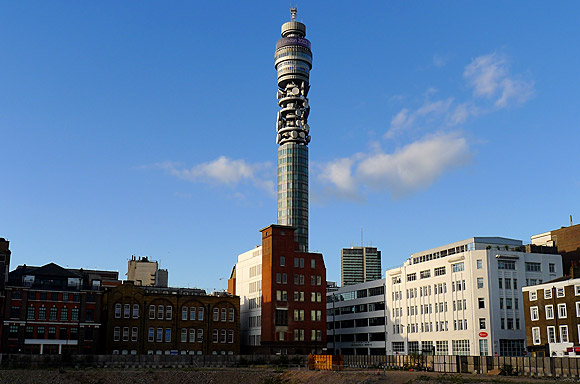
I’ve long been fascinated by the BT Tower, and back in March 2004, I was lucky enough to get a trip to the top of this Grade II listed structure.
Here’s some photos from that visit.
Obscure fact! Despite the BT Tower being one of most recognisable and conspicuous buildings in London, it was classed as an ‘official secret’ until fairly recently, and taking or possessing photos of the BT/Post Office Tower was technically an offence under the Official Secrets Act!
Wikipedia has the history of this iconic tower:
The tower was commissioned by the General Post Office (GPO). Its primary purpose was to support the microwave aerials then used to carry telecommunications traffic from London to the rest of the country, as part of Britain’s microwave network.
It replaced a much shorter steel lattice tower which had been built on the roof of the neighbouring Museum telephone exchange in the late 1940s to provide a television link between London and Birmingham.
The taller structure was required to protect the radio links’ “line of sight” against some of the tall buildings in London then in the planning stage. These links were routed via other GPO microwave stations at Harrow Weald, Bagshot, Kelvedon Hatch and Fairseat, and to places like the London Air Traffic Control Centre at West Drayton.
The tower was designed by the architects of the Ministry of Public Building and Works: the chief architects were Eric Bedford and G. R. Yeats. Typical for its time, the building is concrete clad in glass.
The narrow cylindrical shape was chosen because of the requirements of the communications aerials: the building will shift no more than 25 centimetres (10 in) in wind speeds of up to 150 km/h (95 mph). Initially, the first 16 floors were for technical equipment and power.
Above that was a 35-metre section for the microwave aerials, and above that were six floors of suites, kitchens, technical equipment and finally a cantilevered steel lattice tower. To prevent heat build-up, the glass cladding was of a special tint. The construction cost was £2.5 million.
Construction began in June 1961; owing to the building’s height and its having a tower crane jib across the top virtually throughout the whole construction period, it gradually became a very prominent landmark that could be seen from almost anywhere in London.
A question was raised in Parliament about the crane, in August 1963. Reginald Bennett MP asked the Minister of Public Buildings and Works, Geoffrey Rippon, how, when the crane on the top of the new Tower had fulfilled its purpose, he proposed to remove it. Rippon replied: “This is a matter for the contractors. The problem does not have to be solved for about a year but there appears to be no danger of the crane having to be left in situ.”
The tower was topped out on 15 July 1964, and officially opened by the then Prime Minister Harold Wilson on 8 October 1965. The main contractor was Peter Lind & Co Ltd.
The tower was originally designed to be just 111 metres (364 ft) high; its foundations are sunk down through 53 metres of London clay, and are formed of a concrete raft 27 metres square, a metre thick, reinforced with six layers of cables, on top of which sits a reinforced concrete pyramid
The tower is still in use today:
The tower… is the site of a major UK communications hub. Microwave links have been replaced by subterranean optical fibre links for most mainstream purposes, but the former are still in use at the tower.
The second floor of the base of the tower contains the TV Network Switching Centre which carries broadcasting traffic and relays signals between television broadcasters, production companies, advertisers, international satellite services and uplink companies.
The outside broadcast control is located above the former revolving restaurant, with the kitchens on floor 35.
At the top of the Tower in the former restaurant. The outside area rotates around the central core, marked by the circular metal strip to the left.
More info about the BT Tower:
What have they done to the BT Tower in London? (2012)
BT Telecom Tower restaurant plans abandoned (2010)
BT Tower history
BT Tower August 2007 visit


